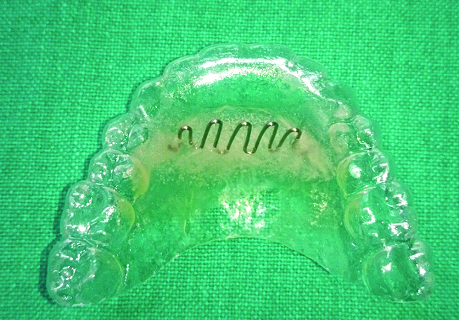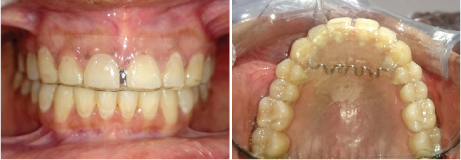Aesthetic Retainer cum Trainer
Tulika Tripathi1, Shilpa Kalra2, Priyank Rai3
1 Senior Professor and Head, Department of Orthodontics and Dentofacial Orthopaedics, Maulana Azad Institute of Dental Sciences, New Delhi, India.
2 Senior Resident, Department of Orthodontics and Dentofacial Orthopaedics, Maulana Azad Institute of Dental Sciences, New Delhi, India.
3 Professor, Department of Orthodontics and Dentofacial Orthopaedics, Maulana Azad Institute of Dental Sciences, New Delhi, India.
NAME, ADDRESS, E-MAIL ID OF THE CORRESPONDING AUTHOR: Dr. Tulika Tripathi, Department of Orthodontics and Dentofacial Orthopaedics, Maulana Azad Institute of Dental Sciences, New Delhi-110002, India.
E-mail: drtulikatripathi@yahoo.com
Tongue thrust habit is one of the contributing factors in the relapse of orthodontic treatment results. Compliance with removable habit breaking appliance is a major issue to the dental practitioners treating patients of any age group. Through this case we introduce a more aesthetic and comfortable option to the patients requiring habit control for tongue thrusting and retention of treatment results. Hence, this appliance acts as a retainer cum trainer in such patients.
Habit breaking,Retention,Tongue thrust
We present a case of 34-year-old female patient with a sound professional background complaining of low self esteem due to unaesthetic spacing between upper and lower anterior teeth. On clinical examination, she was diagnosed with simple tongue thrust habit which led to generalized spacing in upper and lower anterior dental segments.
Considering the patient’s chief concern due to her age and social activity, it was decided to close the spaces in upper and lower dental arches with fixed mechanotherapy with ceramic brackets in the first phase followed by habit breaking cum retention appliance in the second phase. Meanwhile, the patient was trained about the correct tongue posture while swallowing and was instructed to perform necessary tongue exercises. Midline spacing in upper arch was present even after closure of spaces in lower arch and no further retraction could be done without performing interproximal reduction in lower arch. Patient was satisfied with the results and did not want tooth reduction in lower arch and hence, the case was debonded at this stage.
At the end of fixed appliance treatment, patient was to be given retainers for maintenance of the treatment results achieved and simultaneously control of tongue thrust habit was desired which would have otherwise caused relapse of the results achieved.
Considering patient’s age and social indulgence, giving a conventional removable habit breaking appliance with cribs was not a good option because of the unaesthetic appearance of the wire of labial bow and bulkiness of the appliance which would interfere with normal speech of the patient. Because of these concerns, there were chances of non-compliance in appliance wear and hence, it was ruled out. Another option was to give fixed rakes with bands cemented on first molars with fixed lingual bonded retainers for the anterior teeth. Demineralization with cemented bands [1,2] on molars due to long-term use was one of the main reasons for not adopting this retention plan.
Hence, we planned to give an aesthetic retainer cum trainer along with a bonded fixed retainer in the upper arch. This served the purpose of controlling the tongue thrust habit as well as retention of closure of spaces.
A fixed retainer was bonded onto the palatal surface of upper anteriors and impression was taken for fabrication of aesthetic retainer cum trainer. The palatal surface of maxillary anteriors was blocked out with plaster of paris on the cast for ease of fabrication of aesthetic appliance over bonded retainer. An aesthetic retainer was fabricated with 0.625 mm thick Duran sheet using Biostar® (pressure moulding technique) machine on this cast. Customized cribs were made with 22 gauge stainless steel orthodontic wire on another set of post-treatment cast. Now, the customized cribs were positioned and added over the palatal surface of the aesthetic retainer using cold cure acrylic material [Table/Fig-1]. After proper finishing and polishing, the aesthetic retainer cum trainer was fitted in patient’s mouth [Table/Fig-2a, b]. Further palatal extent of the aesthetic retainer was reduced in horse-shoe shape to minimize patient discomfort.
Discussion
Tongue thrust habit has been assumed to be a contributing factor in the relapse of orthodontic treatment results [3–5]. Hence, it is not only an issue to be dealt with in young growing patients but is commonly present in many of our adult patients seeking orthodontic treatment. With respect to high incidence of tongue thrust, patients in all age groups should be observed for evidence of tongue thrust and should be treated accordingly.
Aesthetic retainer cum trainer.

Intraoral frontal and maxillary occlusal view with aesthetic retainer cum trainer in place.

Correction of tongue thrust habit requires both myofunctional therapy and crib therapy [6]. Conventional removable appliance with cribs is not well tolerated by patients and hence, the compliance and appliance wear time is reduced [7,8]. Hence, an aesthetic alternative to conventional habit breaking appliance in patients with tongue thrust habit which can also act as retainer after orthodontic treatment in such patients, is required. An aesthetic retainer was preferred over conventional Hawley’s retainer in this case due to its multiple advantages. The reduced thickness of Duran sheet (0.625 mm) as compared to acrylic plate (2 mm) made the aesthetic retainer more comfortable for the patient and reduced the chances of non-compliance. Adding cribs to train the tongue would be beneficial for the adults who require active habit breaking appliance treatment. Also, it may be used in anterior open bite patients to alter tongue posture with better acceptability prior to orthognathic surgery for correction of skeletal malrelations. Even for young patients giving an aesthetic tongue trainer with reduced thickness and reduced palatal coverage for tongue thrust habit may resolve non-compliance issues. Only disadvantage of this aesthetic retainer cum trainer is that it requires a Biostar® for its fabrication which may not be available in all dental set ups.
Thus, this paper introduces an aesthetic alternative to conventional habit breaking appliance in patients with tongue thrust habit which can also act as retainer after orthodontic treatment in such patients.
Conclusion
Thus, the aesthetic retainer cum trainer served both the purposes of retention and tongue thrust habit control simultaneously. Additionally, this appliance seems to be superior to the presently available options for delivering the optimal treatment for patients with high social activity. Being a very thin appliance, it is believed to interfere minimally with normal speech and comfort of the patient, compliance with this appliance is expected to be far superior to conventional habit breaking appliance in patients of all age groups with tongue thrust.
[1]. Mizrahi E, Surface distribution of enamel opacities following orthodontic treatment Am J Orthod 1983 84(4):323-31. [Google Scholar]
[2]. Ogaard B, Rølla G, Arends J, Orthodontic appliances and enamel demineralization. Part 1. Lesion development Am J Orthod Dentofacial Orthop 1988 94(1):68-73. [Google Scholar]
[3]. Andrianopoulos MV, Hanson ML, Tongue thrust and stability of overjet correction Angle Orthod 1987 57:121-35. [Google Scholar]
[4]. Yashiro K, Takada K, Tongue muscle activity after orthodontic treatment of anterior open bite: A case report Am J Orthod Dentofac Orthop 1999 115:660-66. [Google Scholar]
[5]. Denison TF, Kokich VG, Shapiro PA, Stability of maxillary surgery in open bite versus non-open bite malocclusion Angle Orthod 1989 59:5-10. [Google Scholar]
[6]. Huang GJ, Justus R, Kennedy DB, Kokich VG, Stability of anterior open bite treated with crib therapy Angle Orthod 1990 60:17-24. [Google Scholar]
[7]. Littlewood SJ, Tait AG, Mandall NA, Lewis DH, The role of removable appliances in contemporary orthodontics Br Dent J 2001 191(6):304-10. [Google Scholar]
[8]. Tsomos G, Ludwig B, Grossen J, Pazera P, Gkantidis N, Objective assessment of patient compliance with removable orthodontic appliances: A cross-sectional cohort study Angle Orthod 2014 84(1):56-61. [Google Scholar]